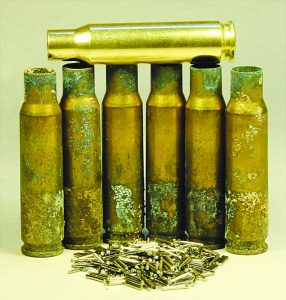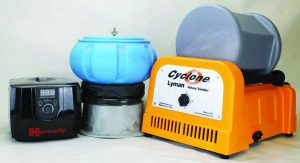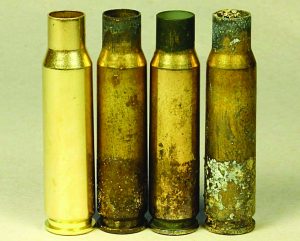By Art Merrill | Contributing Editor

The steel pin/wet media tumbler makes the cruddiest brass shiny new.
So, what’s the best way to clean brass? Define, “best.” “Best” could mean, “fastest” to you, but the next guy might define it as, “cheapest” while to another handloader it means, “easiest.” Then there’s also, “least messy,” “the most brass at once” and “most thorough.” For some folks, “quietest” might be a factor, too.
We have three basic methods for cleaning quantities of brass at one go: the dry media vibratory tumbler, the liquid ultrasonic cleaner, and the fairly new stainless steel pin and liquid rotary tumbler system. The main difference between the rotary and vibratory tumblers is just that: one rolls on its side like a drum, and the other vibrates, which tumbles the brass and media from the outside edge to the center and back out again. Ultrasonic cleaners do their job by essentially “stirring” a liquid with high frequency vibration, which also serves to loosen particles of the stuff that sticks to brass and makes it dirty. How long each method takes to clean satisfactorily depends on the filth factor of our brass, the ratio of brass to media and the “freshness” of the media. After cleaning, we pour the tumbler contents through a sifter that separates media from brass; we may or may not reuse the media.
Old dry standby

Three ways of cleaning brass are (L-R) ultrasonic, dry media vibratory tumbler, and wet media/stainless steel pin rotary tumbler. Definitely not created equal!
Of these three methods, dry media vibratory tumblers have been around in quantity the longest; they may eventually go the way of the Schuetzen rifle, but they are the most popular case cleaner today, likely because start-up cost is the lowest. A small vibratory tumbler may sell for as little as $45, with a bag of walnut shell or corncob media – which might last several years—adding another $15 (about $1 per pound) to that. Their down side is that during use the media breaks down into dust that must be wiped from the brass (and, eventually, the tumbler) after cleaning, and dry media does not clean primer pockets. Dry media doesn’t clean the insides of cases as well as the outside, but it does well enough.
Cleaning takes a couple hours to all night, depending, and we can add a spoonful of liquid or powdered polishing compound to speed matters a bit. Do note that the powdered stuff (rouge) can stick to the insides of cases, though that doesn’t seem to impact reloading to any degree. There are other dry media – plastic, ceramic, etc. – available, but corn cob and walnut shell have shown to work best for our needs.
Vibratory tumblers can be quite loud; most handloaders run them in the garage or basement or otherwise out of earshot.
Ultrasonics
Ultrasonic cleaners can do their thing in a matter of minutes if brass isn’t too dirty. They’re quiet and will somewhat clean primer pockets if you knock out the primers before dumping the brass in, but don’t expect primer pockets to look like-new. When you shake cases around in their bath a bit to ensure no air is trapped inside, ultrasonics will also clean case interiors, as well.
Clean loaded ammo?
“Is it OK to run loaded ammo through a vibratory tumbler?” is a common and reasonable question.
The first concern might be whether loaded cartridges knocking together might fire. While a remote possibility exists (in an “infinite monkeys” kind of way), vibratory tumbler actions really aren’t violent enough to worry about it. And even if a cartridge did go off, the closed tumbler is easily capable of safely containing the event. Townsend Whelen demonstrated that even a cardboard box will fully contain the detonation of a loose cartridge – including the bullet. Counterintuitive perhaps, but demonstrated by experiment as being true.
More reasonable concerns would be the vibratory action loosening bullets or primers, or media dust infiltrating the case via the primer pocket or case mouth (which might affect powder burning and case pressure). However, roll crimps and taper crimps are equally sound. I ran some random loaded cartridges through a four-hour vibratory cleaning as a test; measuring COL before and afterward showed bullets hadn’t moved.
The bullets and primers in military surplus ammo are tightly crimped into place in order to feed ultra-reliably in full auto and semi-auto actions without loosening either component. Additionally, case mouths and primer pockets often get a lacquer seal to prevent moisture intrusion. These two factors contribute to the shelf life of military ammo – on the inside. The outside, however, is subject to ambient conditions, and improper storage can result in ammo cases corroded on the exterior. It’s routine, for example, that about 10 percent of the bulk Greek milsurp M2 Ball (.30-06) sold by CMP shows external corrosion. CMP cautions against firing such cases.
Tossing these into a dry media tumbler may not dislodge bullet or primer, or infiltrate dust into the powder, but it also won’t cure a deeper corrosion problem even though tumbling may smooth corrosion’s outer surface. As handloaders we can salvage the bullet and maybe the powder (that’s a different subject), but the corroded cases should be scrapped.
Ultrasonic cleaners are officially sized in quarts or liters, though makers typically give shooters a volume reference we can visualize, such as, “can hold 300 9mm cases.” Prices begin at around $100 for a small ultrasonic cleaner; Lyman ultrasonic cleaning solution, as one example, runs about $10 for a quart of concentrate, which is mixed 1:40 with water, so a little goes a long way. The solution can be re-used, once again depending on the dirtiness and quantity of brass, but the more it’s used, the less effective it is and so cleaning times become longer and brass doesn’t come out as shiny. If in a pinch or pinching pennies, you can find on Youtube plenty of suggestions for homemade cleaning solutions that feature water, dish soap and a mild acid (vinegar, citrus) or ammonia.
Regarding the latter, ammonia likes to eat copper like a fat kid going at a bag of potato chips, and brass is 70 percent copper. The potential for ammonia weakening brass cartridge cases exists, though it is apparently safe enough in adequate dilution. Whether those Youtubers’ recipes safely dilute ammonia, I couldn’t say.
A big bonus with the ultrasonic cleaners is that we can buy a second ultrasonic cleaning solution formulated for cleaning steel gun parts. If going this route, it makes sense to spend more for the largest ultrasonic cleaner we can afford that will hold larger gun parts, such as an entire pistol frame. Another bonus is that they are nearly silent, typically emitting only a quiet hum while they zap the brass.
Drums & steel
If “best” means “like new brass” to you, then the rotary tumbler with liquid media and stainless steel pins is your candidate. Simply dump your brass into the drum with the pins, add enough liquid solution to cover, set the timer for an hour or two, and come back later to find brass sparkling clean. Knocking out the primers before cleaning (use a universal depriming die that does not resize cases) results in primer pockets, perhaps not perfect and new, but clean enough that you don’t need to scrape them out any further. The pins migrate into the cases to clean the insides, too. The liquid media comes out nasty black; I haven’t tried to reuse it. Do the steel pins wear the sharp corners of the brass rims or mouths? I haven’t seen any rounding of those edges with a magnifying glass and I’ve heard of no issues, so the answer is, “Apparently not.”
Starting prices for this system are in the $200 range. The steel pins are available separately at around $25 for five pounds, and so the thought occurs, “Hey, can I just use the pins in my vibratory tumbler?” The answer is, “Not safely.” The vibratory tumbler tub sits atop an electric motor, connected to the center shaft that is deliberately weighted off-center to cause vibration (you can see the counterweight when you invert your tumbler). The steel pins are too heavy for the motors on these tumblers and can cause them to eventually fail, perhaps with attendant arcs and sparks and other unpleasantries.
These rotary tumblers have a rubber lining in the drum to help quiet their operation. Noise-wise, they are a bit less annoying than the vibratory tumblers.
Comparison

The case on the left looked like the case on the right before a trip through the steel pin tumbler. Dry media and ultrasonic cleaning of the two center cases hardly compare.
Note that if brass is corroded on the outside, it may be just as bad on the inside. Corrosion weakens brass and could cause case splits, ruptures or case head separation if fired. It may also cause feeding, chambering and extraction problems, so the wise course of action is to toss those cases exhibiting corrosion. For this evaluation, however, let’s use the nastiest, most corroded bunch of raggedy range brass we can find, with no intent to actually reload them. Luckily, a friend had on hand some 308 Win brass picked up at a desert shooting spot. This stuff had been out in the weather for so many years that the corrosion had somewhat welded the brass to the Styrofoam packaging. I divided the 20 cases among the three types of cleaners, running each for an amount of time typical for each method of cleaning really dirty brass – the dry media vibratory tumbler overnight, the ultrasonic cleaner for about 20 minutes and the steel pin/wet media rotary for two hours.
In a nutshell, the stainless steel pin/wet media method left the other two in the dust, and I suspect the dry media and ultrasonic cleaners wouldn’t have caught up no matter how long they’d run. The cruddy, corroded cases emerged from the rotary drum looking virtually brand shiny new except for the primer pockets, which retained flecks of burned residue, as is wont with this method of cleaning.
So, if cost is your major factor, dry media vibratory is the easiest on the wallet. For multitasking to clean gun parts, the ultrasonic stands alone. For like-new brass, the steel pin system wins hands-down. Isn’t it good to have options?



